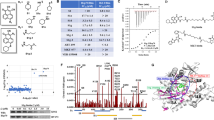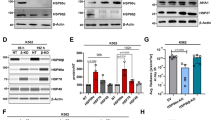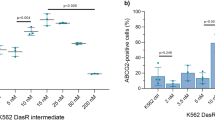Abstract
To overcome imatinib resistance, more potent ABL tyrosine kinase inhibitors (TKIs), such as nilotinib and dasatinib have been developed, with demonstrable preclinical activity against most imatinib-resistant BCR–ABL kinase domain mutations, with the exception of T315I. However, imatinib-resistant patients already harboring mutations have a higher likelihood of developing further mutations under the selective pressure of potent ABL TKIs. NVP-AUY922 (Novartis) is a novel 4,5-diaryloxazole adenosine triphosphate-binding site heat shock protein 90 (HSP90) inhibitor, which has been shown to inhibit the chaperone function of HSP90 and deplete the levels of HSP90 client protein including BCR–ABL. In this study, we investigated the combined effects of AUY922 and nilotinib on random mutagenesis for BCR–ABL mutation (Blood, 109; 5011, 2007). Compared with single agents, combination with AUY922 and nilotinib was more effective at reducing the outgrowth of resistant cell clones. No outgrowth was observed in the presence of 2 μM of nilotinib and 20 nM of AUY922. The observed data from the isobologram indicated the synergistic effect of simultaneous exposure to AUY922 and nilotinib even in BaF3 cells expressing BCR–ABL mutants including T315I. In vivo studies also demonstrated that the combination of AUY922 and nilotinib prolonged the survival of mice transplanted with mixture of BaF3 cells expressing wild-type BCR–ABL and mutant forms. Taken together, this study shows that the combination of AUY922 and nilotinib exhibits a desirable therapeutic index that can reduce the in vivo growth of mutant forms of BCR–ABL-expressing cells.
This is a preview of subscription content, access via your institution
Access options
Subscribe to this journal
Receive 50 print issues and online access
$259.00 per year
only $5.18 per issue
Buy this article
- Purchase on Springer Link
- Instant access to full article PDF
Prices may be subject to local taxes which are calculated during checkout






Similar content being viewed by others
References
Azam M, Latek R, Daley GQ . (2003). Mechanisms of autoinhibition and STI-571/imatinib resistance revealed by mutagenesis of BCR-ABL. Cell 112: 831–843.
Bantscheff M, Eberhard D, Abraham Y, Bastuck S, Boesche M, Hobson S et al. (2007). Quantitative chemical proteomics reveals mechanisms of action of clinical ABL kinase inhibitors. Nat Biotech 25: 1035–1044.
Branford S, Melo JV, Hughes PT . (2009). Selecting optimal second-line tyrosine kinase inhibitor therapy for chronic myeloid leukemia patients after imatinib failure: does the BCR-ABL mutation status really matter? Blood 114: 5426–5435.
Brough PA, Aherne W, Barril X, Borgogononi J, Boxall K, Cansfield JE et al. (2008). 4,5-Diarylisoxazole Hsp90 chaperone inhibitors: potential therapeutic agents for the treatment of cancer. J Med Chem 51: 196–218.
Deguchi Y, Kimura S, Ashihara E, Niwa T, Hodohara K, Fujiyama Y et al. (2008). Comparison of imatinib, dasatinib, nilotinib and INNO-406 in imatinib-resistant cell lines. Leuk Res 32: 980–983.
Eccles SA, Massey A, Raynaud FI, Sharp SY, Box G, Valenti M et al. (2008). NVP-AUY922: a novel heat shock protein 90 inhibitor active against xenograft tumor growth, angiogenesis, and metastasis. Cancer Res 68: 2850–2860.
Garg RJ, Kantarjian H, O'Brien S, Quintas-Cardama A, Faderl S, Estrov Z et al. (2009). The use of nilotinib or dasatinib after failure to 2 prior tyrosine kinase inhibitors: long-term follow-up. Blood 114: 4361–4368.
Gorre ME, Ellwood-Yen K, Chiosis G, Rosen N, Sawyers CL . (2002). BCR-ABL point mutants isolated from patients with imatinib mesylate-resistant chronic myeloid leukemia remain sensitive to inhibitors of the BCR-ABL chaperone heat shock protein 90. Blood 100: 3041–3044.
Jabbour E, Kantarjian H, Jones D, Breeden M, Garcia-Manero G, O'Brien S et al. (2008). Characteristics and outcomes of patients with chronic myeloid leukemia and T315I mutation following failure of imatinib mesylate therapy. Blood 112: 53–55.
Kano Y, Akutsu M, Tsunoda S, Mano H, Sato Y, Honma Y et al. (2001). In vitro cytotoxic effects of a tyrosine kinase inhibitor STI571 in combination with commonly used antileukemic agents. Blood 97: 1999–2007.
Kantarjian H, Cortes J, Kim D-W, Dorlhiac-Llacer P, Pasquini R, DiPersio J et al. (2009). Phase 3 study of dasatinib 140 mg once daily versus 70 mg twice daily in patients with chronic myeloid leukemia in accelerated phase resistant or intolerant to imatinib: 15-month median follow-up. Blood 113: 6322–6329.
Kantarjian H, Giles F, Wunderle L, Bhalla K, O'Brian S, Wassmann B et al. (2006). Nilotinib in imatinib-resistant CML and Philadelphia chromosome-positive ALL. N Engl J Med 354: 2542–2551.
Kantarjian H, Pasquini R, Hamerschlak N, Rousselot P, Holowiecki P, Jootar S et al. (2007). Dasatinib or high-dose imatinib for chronic-phase chronic myeloid leukemia after failure of first-line imatinib: a randomized phase 2 trial. Blood 109: 5143–5150.
Matsuyama W, Wang L, Farrar WL, Faure M, Yoshimura T . (2004). Activation of discoidin domain receptor 1 isoform b with collagen up-regulates chemokine production in human macrophages: role of p38 mitogen-activated protein kinase and NF-kappa B. J Immunol 172: 2332–2340.
Nunoda K, Tauchi T, Takaku T, Okabe S, Akahane D, Sashida G et al. (2007). Identification and functional signature of genes regulated by structurally different ABL kinase inhibitors. Oncogene 26: 4179–4188.
O'Hare T, Eide CA, Deininger MWN . (2007). Bcr-Abl kinase domain mutations, drug resistance, and the road to a cure for chronic myeloid leukemia. Blood 110: 2242–2249.
Ottmann O, Dombret H, Martinelli G, Simonsson B, Guilhot F, Larson RA et al. (2007). Dasatinib induces rapid hematologic and cytogenetic responses in adult patients with Philadelphia chromosome positive acute lymphoblastic leukemia with resistance or intolerance to imatinib: interim results of a phase 2 study. Blood 110: 2309–2315.
Ray A, Cowan-Jacob SW, Manley PW, Mestan J, Griffin JD . (2007). Identification of BCR-ABL point mutations conferring resistance to the Abl kinase inhibitor AMN107 (nilotinib) by a random mutagenesis study. Blood 109: 5011–5015.
Rix U, Hantschel O, Dumberger G, Remsing Rix LL, Planyavsky M, Feenbach NV et al. (2007). Chemical proteomic profiles of the BCR-ABL inhibitors imatinib, nilotinib, and dasatinib reveal novel kinase and nonkinase targets. Blood 110: 4055–4063.
Shah NP, Tran C, Lee FY, Chen P, Norris D, Saywers CL . (2004). Overriding imatinib resistance with a novel ABL kinase inhibitor. Science 305: 399–401.
Stuhmer T, Zollinger A, Siegmund D, Chatterjee M, Grella E, Knop S et al. (2008). Signalling profile and antitumour activity of the novel Hsp90 inhibitor NVP-AUY922 in multiple myeloma. Leukemia 22: 1604–1612.
Tauchi T, Boswell HS, Leibowitz D, Broxneyer HE . (1994). Coupling between p210bcr-abl and Shc and Grb2 adaptor proteins in hematopoietic cells permits growth factor receptor-independent link to ras activation pathway. J Exp Med 179: 167–175.
Weisberg E, Manley PW, Breitenstein W, Bruggen J, Cowan-Jacob SW, Ray A et al. (2005). Characterization of AMN107, a selective inhibitor of native and mutant Bcr-Abl. Cancer Cell 7: 129–141.
Acknowledgements
This work was supported by a ‘High-Tech Research Center’ Project for private universities: matching fund subsidy from the MEXT (Ministry of Education, Culture, Sports, Science and Technology), and by the ‘University-Industry Joint Research Project’ for private universities: matching fund subsidy from the MEXT.
Author information
Authors and Affiliations
Corresponding author
Ethics declarations
Competing interests
TT receives research support from Novartis Pharma K.K.
Rights and permissions
About this article
Cite this article
Tauchi, T., Okabe, S., Ashihara, E. et al. Combined effects of novel heat shock protein 90 inhibitor NVP-AUY922 and nilotinib in a random mutagenesis screen. Oncogene 30, 2789–2797 (2011). https://doi.org/10.1038/onc.2011.3
Received:
Revised:
Accepted:
Published:
Issue Date:
DOI: https://doi.org/10.1038/onc.2011.3
Keywords
This article is cited by
-
Combined HSP90 and kinase inhibitor therapy: Insights from The Cancer Genome Atlas
Cell Stress and Chaperones (2015)
-
Combination therapy with nilotinib for drug-sensitive and drug-resistant BCR-ABL-positive leukemia and other malignancies
Archives of Toxicology (2014)



